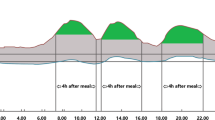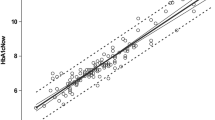Summary
Serum chlorpropamide concentrations (s-CPA) were determined and related to clinical findings in 83 outpatients with maturity onset diabetes. The daily doses of CPA (mg/kg) varied six-fold, but s-CPA ranged 18-fold between the patients. There was a significant correlation between dose and s-CPA (r=0.61), which rose to 0.75 in the 30 patients who had prescribed no other drugs. Patients given other drugs concomitantly were over-represented amongst subjects with extreme values of apparent plasma clearance of CPA. There was no correlation either between serum creatinine or age and s-CPA. Of the 83 patients 40 (48%) had acceptable blood and urinary glucose values according to our criteria; but as 17 were overweight, only 23 patients (28%) had acceptable clinical control. Of the remaining 60 patients, too low a dose was being given to only 12, and dietary failure was the most probable explanation in the others. Thirteen patients (16%) probably did not need CPA. It is likely that this is a partial explanation for the high utilisation of oral antidiabetic drugs in Sweden. There was no general correlation between dose or s-CPA and blood glucose values, but analysis of s-CPA may still be of value in explaining unexpected changes in clinical control.
Similar content being viewed by others
References
Bergman U, Elmes P, Halse M, Halvorsen T, Hood H, Lunde PKM, Sjöqvist F, Wade OL, Westerholm B (1975) The measurement of drug consumption. Drugs for diabetes in Northern Ireland, Norway and Sweden. Eur J Clin Pharmacol 8: 83–89
Bergman U (1979) International comparisons of drug utilization. Antidiabetic drugs in seven European countries. In: Bergman U, Grímson A, Wahba AHW, Westerholm B (eds) Studies in drug utilization. Methods and applications. World Health Organization, Copenhagen (WHO Regional Publications, European Series no 8)
Wade OL, Hadden DR, Hood H (1973) The prescribing of drugs used in the treatment of diabetes. Br J Prev Soc Med 27: 44–48
Prescott LF, Redman DR (1972) Gas-liquid chromatographic estimation of tolbutamide and chlorpropamide in plasma. J Pharm Pharmacol 24: 713–716
Wagner JG, Northam JJ, Alway CD, Carpenter OS (1965) Blood levels of drug at the equilibrium state after multiple dosing. Nature 207: 1301–1302
Taylor JA (1972) Pharmacokinetics and biotransformation of chlorpropamide in man. Clin Pharmacol Ther 13: 710–718
Bergman U (1978) Drug utilization — geographical differences and clinical implications — antidiabetic drugs. In: Duchène-Marullaz P (ed) Advances in pharmacology and therapeutics, vol. 6. Pergamon Press, Oxford New York pp 123–132
Melander A, Sartor G, Wåhlin E, Scherstén B, Bitzén PO (1978) Serum tolbutamide and chlorpropamide concentrations in patients with diabetes mellitus. Br. Med. J. 1: 142–144
Bechtel P, Richard A, Sandoz M, Grandmottet P, Narboni G, Schwager JC (1976) Usefulness of determination of plasma concentrations of glicazide in monitoring the treatment of diabetics. In: Siest G, Young N, Young DS (eds) Drug interference and drug measurement in clinical chemistry. Karger, Basel, pp 153–158
Shen SH, Bressler R (1977) Clinical pharmacology of oral antidiabetic agents. N Engl J Med 296: 493–497
Marble A, Selenkow HA, Rose LI, Dluky RG, Williams GH (1976) Endocrine diseases. In: Avery GS (ed) Drug treatment. Principles and practice of clinical pharmacology and therapeutics. Adis Press, Churchill Livingstone, Sydney, London, pp 386–424
Krall LP, Chabot VA (1978) Oral hypoglycemic agent update. Med Clin North Am 62: 681–694
Petitpierre B, Perrin L, Rudhardt M, Herrera A, Fabre J (1972) Behaviour of chlorpropamide in renal insufficiency and under the effect of associated drug therapy. Int J Clin Pharmacol 6: 120–124
Taylor T, Assinder DF, Chasseaud LF, Bradford PM, Burton JS (1977) Plasma concentrations, bioavailability and dissolution of chlorpropamide. Eur J Clin Pharmacol 11: 207–212
Alván G (1978) Individual differences in the disposition of drugs metabolised in the body. Clin. Pharmacokinet 3: 155–175
Logie AW, Galloway DB, Petrie JC (1976) Drug interactions and long-term antidiabetic therapy. Br J Clin Pharmacol 3: 1027–1032
Hansen IM, Christensen LK (1977) Drug interactions with oral hypoglycemic drugs. Drugs 13: 24–34
Sackett DL (1976) The magnitude of compliance and noncompliance: In: Sackett DL, Haynes RB (eds) Compliance with therapeutic regimens. John Hopkins University Press, Baltimore, pp 9–25
Wiholm B-E (1980) Irregular drug intake and serum chlorpropamide concentrations. Eur J Clin Pharmacol 18: 159–163
Tomkins AM, Bloom A (1972) Assessment of the need for continued oral therapy in diabetics. Br Med J 1: 649–651
Lev-Ran A (1974) Trial of placebo in long-term chlorpropamide-treated diabetics. Diabetologia 10: 197–200
Gonen B, Rubenstein AH (1978) Haemoglobin Al and diabetes mellitus. Diabetologia 15: 1–8
Author information
Authors and Affiliations
Rights and permissions
About this article
Cite this article
Bergman, U., Christenson, I., Jansson, B. et al. Wide variation in serum chlorpropamide concentration in outpatients. Eur J Clin Pharmacol 18, 165–169 (1980). https://doi.org/10.1007/BF00561585
Received:
Accepted:
Issue Date:
DOI: https://doi.org/10.1007/BF00561585




